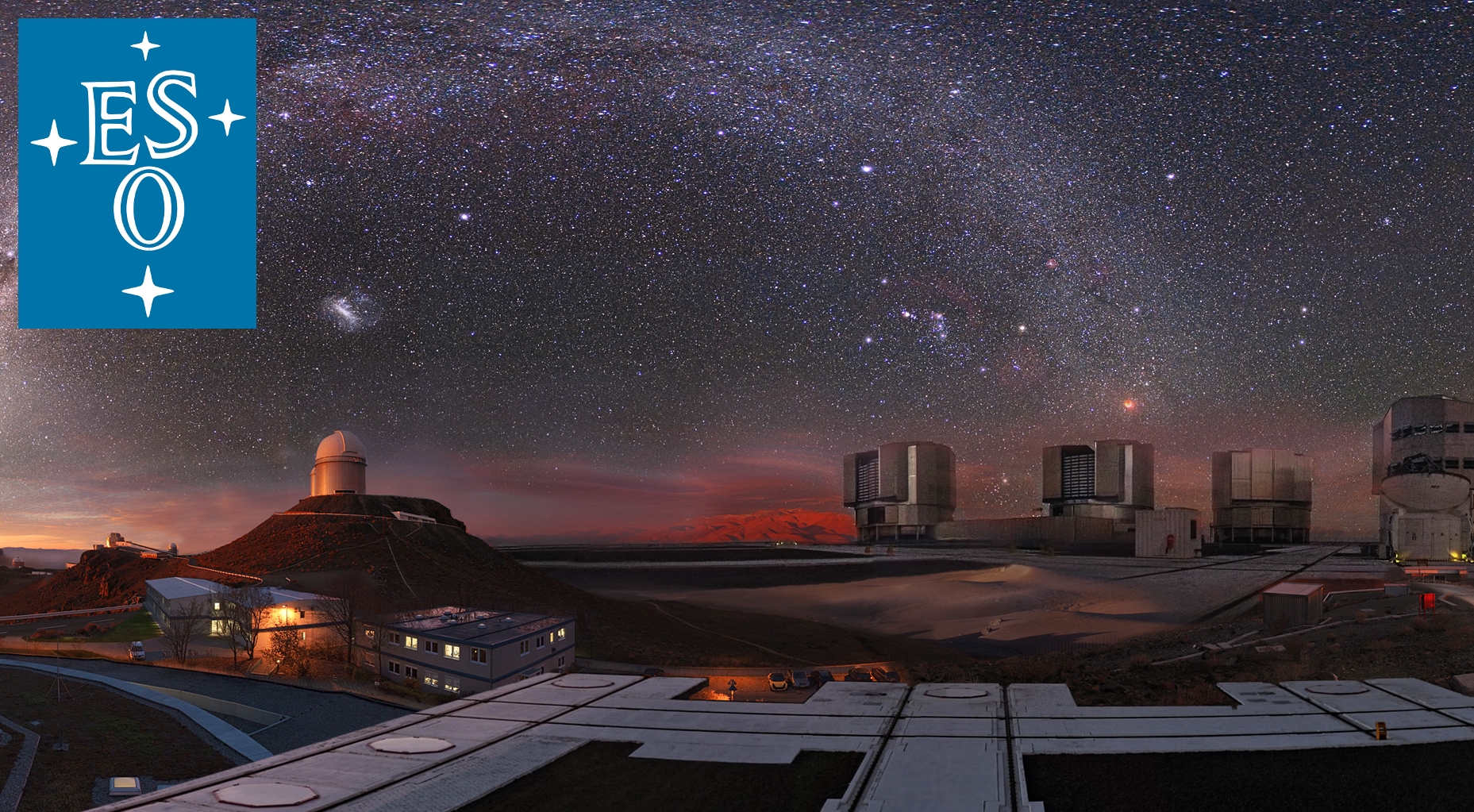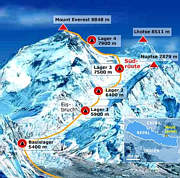
漢德百科全書 | 汉德百科全书
 英国
英国

Die vielen Beobachtungseinrichtungen der ESO verhalfen der Astronomie zu zahlreichen Entdeckungen und produzierten einige astronomische Kataloge.
Unter anderen wurden an ESO-Observatorien der bis heute am weitesten entfernte Gammablitz beobachtet sowie Beweise für die Existenz eines Schwarzen Lochs im Zentrum unserer Milchstraße gefunden.
Die Zunahme der Expansionsgeschwindigkeit des Universums konnte basierend auf Beobachtungen weit entfernter Supernovae mit den Teleskopen auf La Silla gezeigt werden.[2]
Das Very Large Telescope (VLT, deutsch sehr großes Teleskop) konnte zum ersten Mal Kohlenmonoxid-Moleküle in einer Galaxie in einer Entfernung von etwa elf Milliarden Lichtjahren analysieren. Dies ermöglichte die Erlangung der präzisesten Messergebnisse der Temperatur für eine derart entfernte Epoche.[3]
Ebenso mit dem VLT konnten Astronomen das größte gemessene Alter eines Sterns in unserer Milchstraße bestimmen. Mit seinen 13,2 Milliarden Jahren wurde der Stern in einer der frühesten Phasen der Sternentstehung im Universum geboren.[4]
2004 konnte mit Hilfe des VLT das erste Bild eines extrasolaren Planeten (2M1207 b) aufgenommen werden. Seither konnten mit dem Spektrografen HARPS viele weitere extrasolare Planeten aufgespürt werden.
Nach in Summe über 1000 Beobachtungsnächten auf La Silla, die sich über 15 Jahre hin erstreckten, konnten die Bewegungsmuster von mehr als 14.000 sonnenähnlichen Sternen in Nachbarschaft der Sonne bestimmt werden. Es konnte somit gezeigt werden, dass unsere Heimatgalaxie ein turbulenteres und chaotischeres Leben durchmachte als zuvor angenommen wurde.[5]
欧洲南方天文台(英语:The European Southern Observatory,缩写:ESO)是为在南半球研究天文学,在政府间组织的一个研究机构,由15个国家组成和支援的一个天文研究组织。它成立于1962年,目的是为欧洲天文学家提供先进的设施和捷径以研究南方的天空。这个组织总部设在德国慕尼黑附近的加兴,雇用了约730名工作人员,每年并接受成员国约1亿3100万欧元的经费[1]。
欧洲南方天文台建设和经营一些已知规模最大和技术最先进的望远镜,包括首创主动光学技术的新技术望远镜、和由4个8米等级的望远镜和4个1.8米辅助望远镜组成的甚大望远镜。目前由ESO进行的计划包括亚他加马大型毫米波阵列和欧洲极大望远镜。
ALMA是下一个十年最大的地面天文专案,将成为在毫米与次毫米波尺度下观测的主要新工具。他的建设正在进行中,预计于2013年完成。ALMA专案是欧洲各国、亚洲、北美洲和智利之间的国际合作计划。欧洲执行权由ESO代表行使,并且还主持ALMA区域中心[2]。
E-ELT是40米等级的望远镜,目前还在细部设计阶段,将是世界上观测天空最大的巨眼。 欧洲极大望远镜,它将极有力的推动天文物理学的知识,能够仔细研究的天体,包括围绕着其它恒星的行星、宇宙中的第一个天体、超大质量黑洞、和主宰宇宙的暗物质与暗能量的自然本质和分布。从2005年底,ESO就一直与工作和使用社群的欧洲天文学家和天文物理学家共同来定义此新的聚型望远镜[3]。
ESO的观测机构已经作出许多重大的天文发现和一些天体目录[4]。最近的研究结果包括发现最遥远的伽玛射线暴和我们的星系,银河系,中心有黑洞的证据。2004年,甚大望远镜让天文学家获得第一张在173光年外环绕着的棕矮星的系外行星2M1207b轨道的绝佳影像。安装在ESO另一架望远镜上的仪器,高精度径向速度行星搜索器发现许多的系外行星,包括迄今发现最小的系外行星格利泽581c。甚大望远镜还发现迄今距离人类最遥远星系的候选者阿贝尔1835 IR1916。
ヨーロッパ南天天文台(ヨーロッパなんてんてんもんだい、European Southern Observatory、略称:ESO)は、ヨーロッパ14ヶ国およびブラジルが共同で運営する天文観測施設である。1964年に設立された。チリにある天文台を運営している。本部はミュンヘン近郊のGarchingにある。ラ・シヤ天文台(La Silla Observatory)、パラナル天文台(Paranal Observatory)、チャナントール天文台(Llano de Chajnantor Observatory)がおもな施設である。
The European Southern Observatory (ESO), formally the European Organisation for Astronomical Research in the Southern Hemisphere[2], is a 16-nation intergovernmental research organization for ground-based astronomy. Created in 1962, ESO has provided astronomers with state-of-the-art research facilities and access to the southern sky. The organisation employs about 730 staff members and receives annual member state contributions of approximately €162 million.[3] Its observatories are located in northern Chile.
ESO has built and operated some of the largest and most technologically advanced telescopes. These include the 3.6 m New Technology Telescope, an early pioneer in the use of active optics, and the Very Large Telescope (VLT), which consists of four individual 8.2 m telescopes and four smaller auxiliary telescopes which can all work together or separately. The Atacama Large Millimeter Array observes the universe in the millimetre and submillimetre wavelength ranges, and is the world's largest ground-based astronomy project to date. It was completed in March 2013 in an international collaboration by Europe (represented by ESO), North America, East Asia and Chile.[4][5]
Currently under construction is the Extremely Large Telescope. It will use a 39.3-metre-diameter segmented mirror, and become the world's largest optical reflecting telescope when operational in 2024. Its light-gathering power will allow detailed studies of planets around other stars, the first objects in the universe, supermassive black holes, and the nature and distribution of the dark matter and dark energy which dominate the universe.
ESO's observing facilities have made astronomical discoveries and produced several astronomical catalogues.[6] Its findings include the discovery of the most distant gamma-ray burst and evidence for a black hole at the centre of the Milky Way.[7][8] In 2004, the VLT allowed astronomers to obtain the first picture of an extrasolar planet (2M1207b) orbiting a brown dwarf 173 light-years away.[9] The High Accuracy Radial Velocity Planet Searcher (HARPS) instrument installed on the older ESO 3.6 m telescope led to the discovery of extrasolar planets, including Gliese 581c—one of the smallest planets seen outside the solar system.[10]
L’Observatoire européen austral (en anglais, European Southern Observatory : ESO), officiellement nommé l'Organisation européenne pour des observations astronomiques dans l’hémisphère austral1 (European Organisation for Astronomical Research in the Southern Hemisphere), est une organisation intergouvernementale pour l’astronomie fondée en 1962 par cinq pays européens, afin de créer un observatoire astronomique de pointe au sol dans l'hémisphère austral à disposition des astronomes.
L'ESO est l'acteur principal de l'astronomie observationnelle européenne. Il possède des télescopes allant de 2,2 à 8,20 mètres de diamètre, un parc d'une vingtaine d'instruments, dont 15 à Paranal, permettant des observations en imagerie, photométrie, spectroscopie, interférométrie dans à peu près toutes les longueurs d'onde allant du proche ultraviolet à l'infrarouge thermique (vers 20 microns). L'organisation possède également un système complet d'archivage des données, en partenariat avec l'agence de coordination entre l'Europe et le télescope spatial Hubble.
Son siège se trouve à Garching bei München près de Munich en Allemagne ; il dispose de bureaux au Chili à Vitacura dans la capitale Santiago du Chili. En 2018, l'organisation compte 16 états membres et trois sites d'observations, tous au Chili : l'Observatoire de La Silla, l'Observatoire du Cerro Paranal, où se trouve le Very Large Telescope, et l'Observatoire du Llano de Chajnantor.
L’Osservatorio Europeo Australe (ESO, dall'inglese European Southern Observatory, formalmente Organizzazione europea per la ricerca astronomica nell'emisfero australe) è un'organizzazione astronomica internazionale, di cui a settembre 2018 fanno parte sedici nazioni.[1] Creata nel 1962, l'ESO fornisce agli astronomi strumenti all'avanguardia e un accesso al cielo australe. L'organizzazione impiega circa 730 persone e riceve contributi annui di circa 143 milioni di Euro da parte degli Stati membri.[2]
ESO ha costruito e gestito alcuni dei più grandi e più avanzati telescopi del mondo, come il New Technology Telescope (NTT), il telescopio che lanciò la tecnologia dell'ottica attiva e il VLT (Very Large Telescope), composto da quattro telescopi principali (UT) con specchi primari di 8,2 metri di diametro e quattro telescopi ausiliari mobili (in inglese, Auxiliary Telescope, AT) di 1,8 metri di diametro. Ultimo progetto sviluppato da ESO è l'Atacama Large Millimeter Array (ALMA), mentre in fase di sviluppo si trova l'European Extremely Large Telescope (E-ELT).
Atacama Large Millimeter Array (ALMA) è un osservatorio rivoluzionario per l'osservazione dell'universo nelle radiazioni millimetriche/submillimetriche ed è attualmente il più grande progetto astronomico da terra. La sua costruzione è stata completata nel 2013. Il progetto ALMA è una collaborazione internazionale tra l'Europa (rappresentata da ESO), il sud est asiatico, l'America del Nord e la Repubblica del Cile.[3][4]
Uno dei più ambiziosi progetti di ESO è l'E-ELT (che sta per European Extremely Large Telescope), un telescopio di 39 metri di diametro, basato su un design innovativo con 5 specchi. Una volta costruito l'E-ELT sarà il più grande telescopio ottico/infrarosso al mondo. ESO ha cominciato la fase di design di questo telescopio all'inizio del 2006, con lo scopo di essere pronti a costruirlo nel 2014.[5] L'E-ELT dovrebbe essere pronto nel 2025. La grande capacità di accumulare la luce dell'E-ELT permetterà studi dettagliati di pianeti attorno ad altre stelle, dei primi oggetti dell'universo, di buchi neri supermassicci e della natura e della distribuzione della materia e dell'energia oscura che dominano l'universo.
I numerosi strumenti di osservazione di ESO hanno permesso molte scoperte astronomiche e prodotto diversi cataloghi astronomici.[6] Tra le più recenti scoperte: il più distante lampo gamma e il buco nero al centro della nostra galassia, la Via Lattea.[7][8] Nel 2004 il VLT ha dato agli astronomi la possibilità di ottenere la prima foto di un pianeta extra-solare, 2M1207b, che orbita attorno ad una nana bruna distante 173 anni-luce.[9] Lo spettrografo HARPS ha permesso la scoperta di molti altri pianeti extra-solari, incluso un pianeta 5 volte più pesante della Terra che orbita attorno ad una nana rossa, chiamato Gliese 581c.[10] Il VLT ha anche scoperto la galassia più lontana mai vista dall'uomo, Abell 1835 IR1916.
La Organización Europea para la Investigación Astronómica en el Hemisferio Austral (en inglés European Organisation for Astronomical Research in the Southern Hemisphere o European Southern Observatory), más conocida como el Observatorio Europeo Austral o Del Sur es una organización astronómica intergubernamental creada en el año 1962, dedicada a la astrofísica y al desarrollo y operación de telescopios en la Zona Norte de Chile.
Sus oficinas centrales están en Garching, cerca de Múnich, Alemania, y además cuenta con una oficina en Santiago, Chile.
Uno de los proyectos más destacados del ESO es el Telescopio Europeo Extremadamente Grande, la propuesta para la nueva generación de telescopios ópticos terrestres.
Европейская южная обсерватория, (англ. ESO, European Southern Observatory, официальное название — Европейская организация астрономических исследований в Южном полушарии) — международная исследовательская организация, членами которой являются 15 европейских государств и Бразилия.
Идея создания объединённой европейской обсерватории появилась в Лейденской обсерватории в Нидерландах весной 1953 года у Вальтера Бааде и Яна Оорта. 21 июня того же года Оорт собрал группу астрономов в Лейдене, чтобы обсудить возможность её создания. Позднее этот вопрос был поднят на Гронингской конференции, также проводившейся в Нидерландах. 26 января 1954 года декларация ESO была подписана ведущими астрономами шести европейских стран за создание совместной европейской обсерватории в южном полушарии.[1]
Выбор южного полушария был обоснован тем, что все крупные рефлекторные телескопы на тот момент находились в северном полушарии. Кроме того, многие объекты, такие как центральная часть Млечного Пути и Магеллановы облака, доступны только из южного полушария. Изначально планировалось, что телескопы будут располагаться в Южной Африке, однако в ходе наблюдений выяснилось, что условия в Южных Андах более предпочтительны, и 15 ноября 1963 года местом расположения обсерватории была выбрана Республика Чили.[2]
До принятия этого решения 5 октября 1962 года Бельгией, Германией, Францией, Нидерландами и Швецией была подписана Конвенция ESO, а на должность генерального директора был назначен Отто Хекман.
Первые телескопы ESO, расположенные в Ла-Силье, начали работать в 1966 году.[1] В 1980 году штаб-квартира европейского департамента ESO была перенесена в Гархинг под Мюнхеном, Германия.
 阿尔巴尼亚
阿尔巴尼亚
 安道尔
安道尔
 亚美尼亚
亚美尼亚
 阿塞拜疆
阿塞拜疆
 比利时
比利时
 波斯尼亚和黑塞哥维那
波斯尼亚和黑塞哥维那
 保加利亚
保加利亚
 丹麦
丹麦
 联邦德国
联邦德国
 爱沙尼亚
爱沙尼亚
 芬兰
芬兰
 法国
法国
 格鲁吉亚
格鲁吉亚
 希腊
希腊
 爱尔兰
爱尔兰
 冰岛
冰岛
 意大利
意大利
 克罗地亚
克罗地亚
 拉脱维亚
拉脱维亚
 列支敦斯登
列支敦斯登
 立陶宛
立陶宛
 卢森堡
卢森堡
 马耳他
马耳他
 摩尔多瓦
摩尔多瓦
 摩纳哥
摩纳哥
 黑山
黑山
 荷兰
荷兰
 北马其顿
北马其顿
 挪威
挪威
 奥地利
奥地利
 波兰
波兰
 葡萄牙
葡萄牙
 罗马尼亚
罗马尼亚
 俄罗斯
俄罗斯
 圣马力诺
圣马力诺
 瑞典
瑞典
 瑞士
瑞士
 塞尔维亚
塞尔维亚
 斯洛伐克
斯洛伐克
 斯洛文尼亚
斯洛文尼亚
 西班牙
西班牙
 捷克
捷克
 土耳其
土耳其
 乌克兰
乌克兰
 匈牙利
匈牙利
 英国
英国
 塞浦路斯
塞浦路斯
 阿尔巴尼亚
阿尔巴尼亚
 安道尔
安道尔
 亚美尼亚
亚美尼亚
 阿塞拜疆
阿塞拜疆
 比利时
比利时
 波斯尼亚和黑塞哥维那
波斯尼亚和黑塞哥维那
 保加利亚
保加利亚
 丹麦
丹麦
 联邦德国
联邦德国
 爱沙尼亚
爱沙尼亚

 欧洲联盟
欧洲联盟
 芬兰
芬兰
 法国
法国
 格鲁吉亚
格鲁吉亚
 希腊
希腊
 爱尔兰
爱尔兰
 冰岛
冰岛
 意大利
意大利
 科索沃
科索沃
 克罗地亚
克罗地亚
 拉脱维亚
拉脱维亚
 列支敦斯登
列支敦斯登
 立陶宛
立陶宛
 卢森堡
卢森堡
 马耳他
马耳他
 摩尔多瓦
摩尔多瓦
 摩纳哥
摩纳哥
 黑山
黑山
 荷兰
荷兰
 北马其顿
北马其顿
 挪威
挪威
 奥地利
奥地利

 政党和政府组织
政党和政府组织

 政党和政府组织
政党和政府组织
 欧洲政治共同体高峰会议
欧洲政治共同体高峰会议
 波兰
波兰
 葡萄牙
葡萄牙
 罗马尼亚
罗马尼亚
 圣马力诺
圣马力诺
 瑞典
瑞典
 瑞士
瑞士
 塞尔维亚
塞尔维亚
 斯洛伐克
斯洛伐克
 斯洛文尼亚
斯洛文尼亚
 西班牙
西班牙
 捷克
捷克
 土耳其
土耳其
 乌克兰
乌克兰
 匈牙利
匈牙利
 英国
英国
 塞浦路斯
塞浦路斯

Die Europäische Politische Gemeinschaft (EPG)[1] (französisch Communauté politique européenne, CPE; englisch European Political Community, EPC) ist eine europäische, zwischenstaatliche Organisation aus 47 europäischen und vorderasiatischen Staaten, die in den Bereichen Politik, Sicherheit, Energie, Verkehr, Investitionen, Infrastruktur und Personenverkehr zusammenarbeiten. Sie ist eine eigene Institution, welche weder mit der Europäischen Union (die zu den Teilnehmern der EPG gehört) noch mit dem Europarat zusammenhängt. Das EPG-Gründungstreffen fand am 6. Oktober 2022 in der tschechischen Hauptstadt Prag statt.
Im Rahmen der EPG sollen die EU-Beitrittskandidaten, die EFTA-Mitgliedstaaten sowie das Vereinigte Königreich als ehemaliges EU-Mitglied enger an die Europäische Union gebunden und ihnen so eine Möglichkeit der Mitarbeit in deren Politikfeldern gegeben werden, ohne Vollmitglied sein zu müssen. Daher wurde dieses Format auch bereits als eine Art „assoziierte EU-Mitgliedschaft“ beschrieben. Als Hintergrund ist auch zu sehen, dass die derzeitigen Beitrittskandidaten größtenteils als noch nicht beitrittsfähig angesehen werden, man ihrem Wunsch der engeren Kooperation aber (zunächst) auf diese Weise entsprechen will bzw. andere Teilnehmerstaaten derzeit nicht EU-Mitglied werden wollen. Fast alle Teilnehmer sind gleichzeitig auch Mitglied des Europarats.
Während der Vorschlag der Europäischen Politischen Gemeinschaft von 1952 ein Versuch war, eine umfassende politische Integration europäischer Staaten zu verwirklichen, und an dieser nur die sechs damaligen Mitglieder der Europäischen Gemeinschaft für Kohle und Stahl (EGKS oder auch „Montanunion“) teilnehmen sollten, hat die neue, 70 Jahre später vorgeschlagene, Gemeinschaft einen lockereren, intergouvernmentalen Ansatz.
欧洲政治共同体(英語:European Political Community,简称:EPC),是成立于2022年的欧洲政治和战略讨论平台。该集团于2022年10月在捷克布拉格举行首届会议,欧盟所有27个成员国及17个非欧盟国家首脑与会。

 巴伐利亚州
巴伐利亚州
 联邦德国
联邦德国
 意大利
意大利
 军用飞机
军用飞机
 狂风战斗机
狂风战斗机
 军用飞机
军用飞机
 狂风战斗机 ADV
狂风战斗机 ADV
 军用飞机
军用飞机
 狂风战斗机 ECR
狂风战斗机 ECR
 军用飞机
军用飞机
 狂风战斗机 GR.4
狂风战斗机 GR.4
 军用飞机
军用飞机
 狂风战斗机 IDS
狂风战斗机 IDS
 军用飞机
军用飞机
 狂风战斗机 RECCE
狂风战斗机 RECCE

 企业
企业
 英国
英国






Der Mount Everest ist ein Berg im Himalaya und mit einer Höhe von 8848 m der höchste Berg der Erde. Er gehört zu den 14 Achttausendern und zu den Seven Summits. Der Mount Everest ist seit 1856 nach dem britischen Landvermesser George Everest benannt. Auf Nepali heißt der Berg Sagarmatha, auf Tibetisch Qomolangma (deutsche Aussprache „Tschomolangma“; englische Umschrift Chomolungma).
Der Mount Everest befindet sich im Mahalangur Himal in der Region Khumbu in Nepal an der Grenze zu China (Autonomes Gebiet Tibet); der westliche und südöstliche seiner drei Gipfelgrate bilden die Grenze. Auf nepalesischer Seite ist er Teil des Sagarmatha-Nationalparks, der zum UNESCO-Welterbe gehört. Auf der Nordseite gehört er zum Qomolangma National Nature Reserve, das mit dem von der UNESCO ausgewiesenen Qomolangma-Biosphärenreservat korrespondiert.[1]
Edmund Hillary und Tenzing Norgay gelang am 29. Mai 1953 die Erstbesteigung des „dritten Pols“. Am 8. Mai 1978 bestiegen Reinhold Messner und Peter Habeler den Gipfel erstmals ohne zusätzlichen Sauerstoff.
珠穆朗玛峰是喜玛拉雅山脉的主峰,又称圣母峰,英文名Mt.Everest,海拔8848米,是地球上第一高峰,位于东经 86.9°,北纬27.9°。地处中尼边界东段,北坡在中华人民共和国西藏自治区的定曰县境内,南坡在尼泊尔王国境内,藏语称 “珠穆朗玛”[清康熙五十六年(公元 1717年)编绘的《皇舆全览图》中作“朱母朗马阿林”],意为“神女第三”。
珠 穆朗玛峰山体呈巨型金字塔状,威武雄壮昂首天外,地形极端险峻,环境异常复杂。雪线高度:北坡为5800—6200米,南坡为5500—6100米。东北 山脊、 东南山脊和西山山脊中间夹着三大陡壁(北壁、东壁和西南壁),在这些山脊 和峭壁之间又分布着548条大陆型冰川,总面积达1457.07平方公里,平均厚度达7260米。冰川的补给主要靠印度洋季风带两大降水带积雪变质形成。 冰川上 有千姿百态、瑰丽罕见的冰塔林,又有高达数十米的冰陡崖和步步陷井的明暗 冰裂隙,还有险象环生的冰崩雪崩区。(Quelle:http://news.xinhuanet.com)
珠穆朗玛峰(藏文:ཇོ་མོ་གླང་མ;藏语拼音:qomolangma;威利:jo mo glang ma,香港称珠穆朗玛峰,台湾称圣母峰),中文简称珠峰,尼泊尔名萨加玛塔峰(尼泊尔语:सगरमाथा),英国名埃佛勒斯峰(英语:Mount Everest),为地球第一高峰,属于喜马拉雅山脉,位于中国西藏自治区与尼泊尔萨加玛塔专区边界上。2005年中国国家测绘局测量的岩面高为8,844.43米(29,017.2英尺),尼泊尔则使用传统的雪盖高8,848米(29,029英尺),BBC报道称2010年起两国官方互相承认对方的测量数据[5],中国国家测绘地理信息局则在2018年2月声明否认此说法,仍采用8,844.43米数据至今[6]。它除了是海拔最高的山峰之外,也是距离地心第五远的高峰。[7]它附近的高峰包括8,516米(27,940英尺)的洛子峰、7,855米(25,771英尺)的努子峰和7,580米(24,870英尺)的章子峰。
清朝经过测绘于1719年出版的全国地图上称此峰为“朱姆朗马阿林”,但没有标出高度或用经纬度标出其位置。1856年英属印度测量局首次公布此峰的经纬度及海拔高度,主张此峰8,840米(29,000英尺)是世界第一高峰。1865年英国皇家地理学会接受印度测量局局长安德鲁·史考特·华欧的建议,将此峰命名为“埃佛勒斯峰”,以纪念前任局长乔治·埃佛勒斯。1952年,中国采用“珠穆朗玛峰”为官方名称。
珠穆朗玛峰吸引了许多登山者。主要的攀登路线有两条,一条从尼泊尔东南部出发,经过与洛子峰之间的南坳登顶,称为“标准路线”;另一条则从西藏的北部出发,经过与章子峰之间的北坳登顶。从标准路线登顶对登山技术的挑战不算高,但这条路线的风险包括雪崩、摔落山谷、高山症、冻伤和通过昆布冰瀑的危险。到2016年为止,山上有超过200具尸体,其中一些成为地标。[8][9]
据气象记载,珠穆朗玛峰山顶最低温度为-60°C,最低月平均温度为-35°C,全年平均温度为-29°C,参照北极、南极,因此也被称为“世界第三极”。[10]
エベレスト、エヴェレスト(英: Everest)、またはチョモランマ(チベット語: ཇོ་མོ་གླང་མ[1] Chomolungma, Qomolangma)、サガルマータ(ネパール語: सगरमाथा Sagarmāthā)は、ヒマラヤ山脈にある世界最高峰である。
エベレストはインド測量局(Survey of India)で長官を務めたジョージ・エベレストにちなんで命名された。
1920年代から長きにわたる挑戦の末、1953年にイギリス探検隊のメンバーでニュージーランド出身の登山家であるエドモンド・ヒラリーとネパール出身のシェルパであるテンジン・ノルゲイによって初登頂がなされた。
エベレストの標高については諸説あり、1954年にインド測量局が周辺12ヶ所で測定しその結果を平均して得られた8,848 mという数値が長年一般に認められてきた。1999年、全米地理学協会はGPSによる測定値が8,850mだったと発表した[2]。厳密には地殻変動などの影響によって標高は年々変動していると考えられている。
エベレストの南麓に位置するネパールのサガルマータ国立公園はユネスコの世界遺産に登録されている。
Mount Everest, known in Nepali as Sagarmatha (सगरमाथा) and in Tibetan as Chomolungma (ཇོ་མོ་གླང་མ), is Earth's highest mountain above sea level, located in the Mahalangur Himal sub-range of the Himalayas. The international border between Nepal (Province No. 1) and China (Tibet Autonomous Region) runs across its summit point.
The current official elevation of 8,848 m (29,029 ft), recognized by China and Nepal, was established by a 1955 Indian survey and subsequently confirmed by a Chinese survey in 1975.[1] In 2005, China remeasured the rock height of the mountain, with a result of 8844.43 m. There followed an argument between China and Nepal as to whether the official height should be the rock height (8,844 m., China) or the snow height (8,848 m., Nepal). In 2010, an agreement was reached by both sides that the height of Everest is 8,848 m, and Nepal recognizes China's claim that the rock height of Everest is 8,844 m.[5]
In 1865, Everest was given its official English name by the Royal Geographical Society, upon a recommendation by Andrew Waugh, the British Surveyor General of India. As there appeared to be several different local names, Waugh chose to name the mountain after his predecessor in the post, Sir George Everest, despite George Everest's objections.[6]
Mount Everest attracts many climbers, some of them highly experienced mountaineers. There are two main climbing routes, one approaching the summit from the southeast in Nepal (known as the "standard route") and the other from the north in Tibet. While not posing substantial technical climbing challenges on the standard route, Everest presents dangers such as altitude sickness, weather, and wind, as well as significant hazards from avalanches and the Khumbu Icefall. As of 2017, nearly 300 people have died on Everest, many of whose bodies remain on the mountain.[7]
The first recorded efforts to reach Everest's summit were made by British mountaineers. As Nepal did not allow foreigners into the country at the time, the British made several attempts on the north ridge route from the Tibetan side. After the first reconnaissance expedition by the British in 1921 reached 7,000 m (22,970 ft) on the North Col, the 1922 expedition pushed the north ridge route up to 8,320 m (27,300 ft), marking the first time a human had climbed above 8,000 m (26,247 ft). Seven porters were killed in an avalanche on the descent from the North Col. The 1924 expedition resulted in one of the greatest mysteries on Everest to this day: George Mallory and Andrew Irvine made a final summit attempt on 8 June but never returned, sparking debate as to whether or not they were the first to reach the top. They had been spotted high on the mountain that day but disappeared in the clouds, never to be seen again, until Mallory's body was found in 1999 at 8,155 m (26,755 ft) on the north face. Tenzing Norgay and Edmund Hillary made the first official ascent of Everest in 1953, using the southeast ridge route. Norgay had reached 8,595 m (28,199 ft) the previous year as a member of the 1952 Swiss expedition. The Chinese mountaineering team of Wang Fuzhou, Gonpo, and Qu Yinhua made the first reported ascent of the peak from the north ridge on 25 May 1960.[8][9]
L’Everest, en tibétain ཇོ་མོ་གླང་མ, Qomolangma ou encore Chomolungma, en népalais सगरमाथा, Sagarmāthā, aussi appelé mont Everest, est une montagne située dans la chaîne de l'Himalaya, à la frontière entre le Népal (province no 1 (en)) et la Chine (Tibet).
Il est aperçu par des Européens pour la première fois en 1847 puis, après quelques années d'observations et de calculs, son altitude est établie à 8 848 mètres et il est identifié comme le plus haut sommet du monde. Cette caractéristique lui vaut d'être baptisé de son nom actuel par les Occidentaux en 1865 et, dès les années 1920, de lui attirer l'intérêt des alpinistes qui se lancent à l'assaut de ses pentes. Plusieurs expéditions, en particulier britanniques, se succèdent depuis le versant nord au Tibet. Toutefois, les conditions climatiques extrêmes font leurs premières victimes, parmi lesquelles George Mallory et Andrew Irvine, en 1924, dont on ne saura probablement jamais avec certitude s'ils ont atteint le sommet. En 1950, le Népal autorise l'accès à la montagne depuis le sud offrant des possibilités d'ascension par l'arête Sud-Est, moins périlleuse. Finalement, trois ans plus tard, Edmund Hillary et Tensing Norgay réussissent à vaincre l'Everest. Dès lors, les exploits en tous genres s'enchaînent, alimentant les fantasmes populaires ; mais, en 1996, une série d'accidents mortels vient rappeler les dangers liés à la montagne, portant de nos jours à plus de 200 le nombre de victimes. Pourtant, le tourisme de masse se popularise, fragilisant le milieu naturel malgré les créations du parc national de Sagarmatha en 1976 et de la réserve naturelle du Qomolangma en 1988. Ainsi, plus de 14 000 alpinistes ont tenté l'ascension depuis 1922 et plus de 4 000 l'ont réussie, bien aidés, pour la majorité d'entre eux, par les porteurs sherpas.
Il monte Everest (pron. /ˈɛverest/[1]) è la vetta più alta del continente asiatico e della Terra con i suoi 8 848 m di altitudine s.l.m., situato nella catena dell'Himalaya assieme ad altri ottomila, al confine fra Cina e Nepal. Rientra dunque nelle cosiddette Sette Vette del Pianeta.
El monte Everest es la montaña más alta del planeta Tierra, con una altitud de 8.848 metros (29 029 pies) sobre el nivel del mar.1 Está localizada en el continente asiático, en la cordillera del Himalaya, concretamente en la subcordillera de Mahalangur Himal; marca la frontera entre China y Nepal, considerada como la frontera más alta del mundo.[cita requerida] El macizo incluye los picos vecinos Lhotse, 8516 m (27 940 pies); Nuptse, 7855 m (25 771 pies) y Changtse, 7580 m (24 870 pies).
 天文
天文


 航空航天
航空航天
 科学技术
科学技术
 大东部大区
大东部大区

 手拉手
手拉手



 军事、国防和装备
军事、国防和装备

 能源
能源

 体育
体育
 建筑艺术
建筑艺术
 文化遗产
文化遗产




 艺术
艺术

